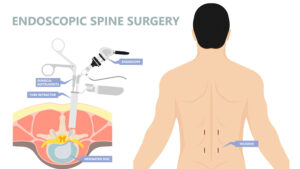Introduction
Endoscopic spine surgery is a minimally invasive surgical technique used to diagnose and treat various spinal conditions. It involves the use of an endoscope, a thin tube with a camera and light attached to it, which allows the surgeon to visualize and access the spine through small incisions. This approach offers several advantages over traditional open surgery, including smaller incisions, reduced trauma to surrounding tissues, faster recovery, and potentially less postoperative pain.

How Endoscopic Spine Surgery Works
Endoscopic spine surgery is performed using the following steps:
Anesthesia: Before the procedure, you will be given anesthesia to ensure that you are comfortable and pain-free during the surgery. The type of anesthesia used will depend on the specific procedure and your individual needs.
Incisions: Small incisions, typically less than an inch in length, are made in the skin near the affected area of the spine.
Endoscope Insertion: An endoscope, which is a thin tube with a camera and light source, is inserted through one of the incisions. This allows the surgeon to visualize the internal structures of the spine on a monitor.
Access and Treatment: Specialized instruments are inserted through additional small incisions or through the same incision as the endoscope. These instruments can be used to remove herniated discs, decompress spinal nerves, repair spinal deformities, or perform other necessary procedures.
Closure: Once the surgical procedure is completed, the incisions are closed with sutures or adhesive strips.
Postoperative Recovery: After the surgery, you will be monitored in a recovery area to ensure your stability and comfort. Pain medications and other supportive measures will be provided as needed. The recovery period for endoscopic spine surgery is typically shorter compared to traditional open surgery.
When Endoscopic Spine Surgery is Needed
Endoscopic spine surgery may be recommended for a variety of spinal conditions, including:
Herniated Disc: When a disc in the spine bulges or ruptures, causing pressure on spinal nerves and resulting in pain, weakness, or numbness.
Spinal Stenosis: This condition involves the narrowing of the spinal canal, leading to compression of the spinal cord or nerves, which can cause pain, numbness, or difficulty walking.
Spinal Deformities: Certain types of spinal deformities, such as scoliosis or kyphosis, may be treated using endoscopic techniques to correct the alignment and relieve symptoms.
Spinal Tumors: Endoscopic surgery can be used to remove small tumors in the spine, depending on their location and characteristics.
Facet Joint Disorders: Endoscopic procedures can be used to diagnose and treat facet joint disorders, such as facet joint arthritis or synovial cysts.
Failed Previous Spinal Surgery: In some cases, endoscopic spine surgery may be considered when previous surgical interventions have not provided satisfactory results or have led to complications.







